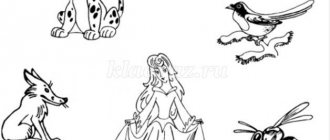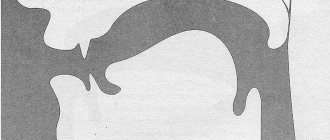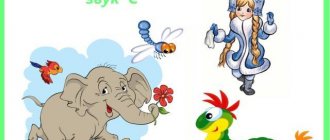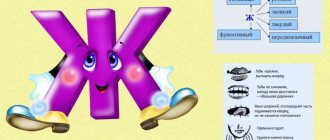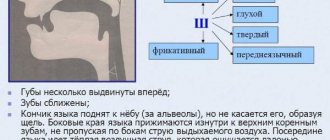Articulation exercises
Before starting the production of Ch, the speech therapist conducts a preparatory stage. Special articulation and breathing exercises are added to the classes:
- The purpose of this exercise is to create an elevation on the front of the tongue, and it also helps strengthen its muscles. The mouth needs to be opened and the tongue made wide. A small candy is placed on its tip. Next, they ask you to stick it to the sky and hold it for several seconds. Only the tongue is used to perform the exercise; there is no need to raise the lower jaw.
- The starting position is a wide open mouth, with the corners stretched in a smile, the front part of the tongue is behind the upper teeth. The child is asked to blow forcefully onto the tip of his tongue so that the exhalation is jerky. Thanks to this exhalation, the tip bounces off. The result should be an analogue of the t sound as in the English word “that”. Gradually, the voice is added to the articulation and the lips are rounded. For the exercise to be correct, the tip of the tongue should rest against the alveoli, and not the upper teeth.
Also, the complex can include tasks for the formation of correct articulation of Ш and the formation of a strong exhalation. At the preparatory stage, clear pronunciation of T, Sh is practiced.
If a child has a distortion of these phonemes, then they are first corrected, and then they begin to set Ch.
Options for setting H
If the pronunciation T, Sh is formed in the child’s speech, then the phoneme can be easily identified by imitation. There are also two popular ways of setting from the soft version of T and a combination of these two sounds:
- They say TH-TH-TH at a fast pace. The tip of the tongue should touch the base of the upper teeth. Then slowly move it a little deeper, the child should smile. When performed correctly, a clear pronunciation of Ch appears in speech.
- Similar to this method. But only if in the previous version there was an accelerated tempo, here the combination T-SH begins to be pronounced at a slow pace, gradually speeding it up. The lips assume a smiling position.
H can be corrected with mechanical assistance. For example, with interdental distortion. When the child pronounces Ch, lift the tip of the tongue with the handle of a spoon. First, up to the alveoli until a closure is formed, then gently moving it deeper into the oral cavity. All this is done in one exhalation.
You first need to reinforce the correct pronunciation of Ch in isolation, then in syllables. But you can move on to the automation stage only when the child can clearly pronounce the desired phoneme.
Differences in sound correction in children and adults
There are no differences in the production of phonemes between children and adults. The only difference is in the way the information is presented. If when working with preschoolers you need to use visual material and supplement articulatory gymnastics with poems and nursery rhymes, then with adults speech therapy classes are structured according to the type of conversation.
Also, for adults, the preparatory stage may take longer. This is due to the fact that their incorrect pronunciation was fixed for a long time. But for adults it is easier to develop the skill of self-control of speech. However, regardless of age, the success of classes depends on the correctness of the selected methods and compliance with all recommendations.
Staging sounds. Sound Ch. OBJECTIVES OF THE LESSON § Educational: - improving the skill of sound-letter analysis; — expansion of the semantic field of words. § Corrective: - automation of the sound [h] in syllables, words, sentences; — development of phonemic processes; — clarification, expansion of the dictionary; — formation of the semantic field of the word “tea” and development of the valency of words; — development of the inflection function; - formation of coherent speech; - development of general, fine and articulatory motor skills. § Educational: - nurturing in children the ability and desire to communicate with each other. You will need individual mirrors, an articulatory sound profile [h], a set of tables with tasks for the formation and development of the inflection function, an explanatory dictionary, a tape recorder, a ball, and cards for exercises on the development of air flow. Organizational moment Speech therapist. Let's repeat the rule of speech. Children Every day, always, everywhere: In class, in play. We say it correctly, clearly, We are not in a hurry. Listening to a sample of correct speech Speech therapist. Listen to a short text in the tape recording. Think about which sound appears in it more often than others. Tanya's mother woke her up. - Get up, daughter! While the girl was getting up, her mother boiled water in the kettle. She poured fresh tea from the teapot into the teapot and poured boiling water over it. She placed tea cups and a bowl of cookies and sweets on the table. - Sit down, daughter, drink tea. Tanya drinks tea, and mom drinks tea. - Daughter, stop drinking tea, it’s time to go to school. Speech therapist. So, today in class we will monitor the correct pronunciation of the sound [h] and recognize this sound in speech. Speech therapy exercises Development of general motor skills Here and below, children perform movements corresponding to the text. Speech therapist One, two - head up, Three, four - head up, Five, six - sit down quietly. Development of fine motor skills Speech therapist One, two, three, four - Mice lived in an apartment. They drank tea, broke cups, and paid three pieces of money. He who doesn't want to pay shouldn't drink tea. Mimic gymnastics Speech therapist. Show with your facial expression: - we drink delicious tea, we like it (joy); — we drink unusual tea (surprise); — they forgot to put sugar in our tea (disappointing). Articulation gymnastics For lips Children stretch their lips in a smile, then round them. For the language Children perform exercises “swing”, “painter”, “horses”. For the development of air flow Speech therapist. Blow on the lemon slice so hard that it ends up in the tea cup. Analysis of the sound [ch] and the letter “ch” Pronunciation of the isolated sound [ch] Acoustic, kinesthetic and visual, tactile-vibration control is connected. Speech therapist. Imagine, we are traveling on a train, drinking tea and listening to the wheels of the carriage knocking. How do the carriage wheels rattle? Children. Ch-ch-ch. Articulatory characteristics of sound [h] An articulatory sound profile and response plan are offered to help. § Lips. § Teeth. § Tongue (tip and back of tongue). § Vocal folds. Phonetic characteristics of sound [h] A table and answer algorithm are provided to help. Vowel - consonant. Prove it. Voiceless - voiced. Prove it. Hard - soft. Name it. Correlating the sound with the letter Speech therapist. What letter represents the sound [h] in writing? How many sounds does the letter “ch” make? What does the letter "h" look like? The letter "ch" said: "There is." I saluted someone. How many elements are in the lowercase letter "h"? Children. Two. The first element is the top (wavy line), the second is the bottom (an inclined line with a curve at the bottom). Speech therapist. Write the letter “h” in the air with a wide wave of your hand. Count one, two, three. The children do it. Write a few lowercase letters “ch” on your desk neighbor’s back. Your neighbor must count and tell you how many letters you wrote. Then switch roles. The children do it. Then the speech therapist shows a picture of a teapot with the letters “h” drawn on it. Find how many letters “h” are hidden on the teapot. Children. Six. Speech therapist. Write in your notebook as many letters “h” as you found on the teapot. Place a dot under the letter that worked best for you. Reading syllables with the sound [h] Speech therapist. Match the teacups to the teapot and read the syllables on them. Automation of the sound [h] using the example of the word “tea” and its derivatives Isolating the main word Speech therapist. Finish the word. Don't be bored, turtle. Drink delicious... (tea) from a cup. Explain how you understand the meaning of the word “tea”. Children work with an explanatory dictionary. TEA is an evergreen plant, dried and specially processed leaves that, when brewed, give a drink. Sound-syllable analysis of the word “tea” Children consistently perform each speech therapist’s task. Speech therapist. Say the word “tea” clearly, pronouncing all the sounds. How many syllables are in the word "tea"? Why? How many sounds are there in the word “tea”, name them sequentially. Determine the place of the sound [h] in the word “tea”. Similar words Speech therapist. Listen to the story again carefully, what drink is being discussed in the story? Graphic cards are posted on the board as answers are given. What did Tanya drink this morning? TEA What did mom boil the water in? KETTLE What do you call a small teapot? TEAPLE What cups did mom put on the table? TEA Read the words, clearly pronouncing the sound [h]. Name the common, identical part in these words. Children. Tea. Development of the inflection function Speech therapist. Count using the table. (Exhibits drawings.) And now we will set the table for Tanya’s tea party. But you can only put on the table those objects whose names contain the sound [h]. A plot picture is displayed: a girl is sitting at a table. Nearby there are object pictures: a teapot, a cup, sweets, cookies, a saucepan, jam, a teapot. What is in front of the teapot, behind the cup, between the bowl of cookies and the cup, near the teapot? Words that answer the question: “What to do?” Speech therapist. Match the word to the picture. What is the girl doing? Students have graphic cards that they must match to the pictures. POURS DRINK BREWS Let's make up phrases. Children read according to instructions. POURING DRINKING BREWING Arrange the pictures in the correct sequence. Children place the cards like this: “brews”, “pours”, “drinks”. Words denoting the attribute of the subject Physical Education Minute. Playing with the ball “On the contrary” Speech therapist. Replace the words that answer the question “which?” The word must have the opposite meaning. Hot tea ………tea Old teapot ………teapot Clean teapot ………teapot Bitter tea ………teapot Match the picture to the words. There are subject pictures on the board, and students have graphic cards. Can you name what is shown in the pictures? Children. Cup, saucer, set, spoons. Speech therapist. Read what is written on your cards. TEA TEA TEA TEA Match the word to the picture. Read the resulting phrases. Working on a speech therapist proposal. Make a sentence based on the picture. Give the girl a name. Children. Tanya drinks tea. Speech therapist. Now let's analyze the proposal. How many words does it have? Children answer this and the following questions, and also complete the proposed tasks. Name the first word (second, third). Name words with the sound [h], determine the place of this sound in the word. Draw an outline of the sentence in your notebook. Write the letter “ch” above the word. Well done! Now let's test ourselves. Summary of the lesson The speech therapist praises the children for their good work and reports on the successes achieved.
Correction of parasigmatism
Parasigmatisms arise as a result of incorrect articulation and underdevelopment of phonetic-phonemic processes, namely phonemic hearing. Therefore, in addition to articulatory gymnastics, tasks for the development of phonemic hearing are added to the preparatory work:
- In case of the whistling variant of the defect (when the child replaces H with S), training is carried out to distinguish between mixed sounds. The speech therapist explains and shows their articulation, emphasizing their differences. Also offered are tasks for distinguishing H and S by ear. The speech therapist suggests comparing the exhaled stream: when pronouncing S it is cold, H it is warm. In articulation exercises, the emphasis is on the formation of a lift of the tongue and a strong, jerky air stream.
- With the labial-dental variant, similar work is carried out, but only to distinguish between Ch and F. The speech therapist also massages the lips, focuses on them in articulatory gymnastics, as well as on raising the tongue.
With nasal pronunciation, the emphasis in work is on the formation of adequate speech breathing. The child is taught to distinguish between oral and nasal exhalation. In articulation exercises, tasks are selected to form the rise of the tip of the tongue and hold it behind the upper teeth, and also teach how to direct an air stream at it.
Pronunciation is normal
The sound Ch occupies a special place among hissing sounds due to the peculiarities of its articulation. It is obtained by combining T and Sh. When a person pronounces Ch, his lips slightly round and move forward. The dentitions are closed, a small gap is formed between them.
To pronounce this sound correctly, the tongue is made wide. They lift it and touch the hard palate with the tip closer to the teeth. The middle part of the back is lowered, the sides touch the upper teeth, thus creating a depression. The exhalation must be strong and jerky to pass through the gap created by the alveoli and the front of the tongue.
Setting the sound Ch
Goal: to teach the child to pronounce the standardized sound h
.
Equipment: diagram of the structure of the articulatory apparatus when pronouncing the sound h; probe, spatula; pictures-symbols, subject pictures.
Staging sound in various ways.
1. By imitation:
The child is offered a sample of sound pronunciation in combination with play images (the chirping of a grasshopper, etc.); At the same time, visual control of correct articulation and tactile (tactile) sensations are used.
2. From the merger of the constituent parts of the affricate h:
The child is asked to pronounce the sounds t, sch as he exhales: first slowly, then quickly and sharply (continuously).
3. From reference sound:
The child is asked to pronounce the syllable, paying attention to the connection of the tongue with the alveoli, gradually moving the tongue back; You can additionally imitate the movement of the tongue with your hands.
4. From reference sound with mechanical assistance:
The child is asked to pronounce the sound/syllable t/at, paying attention to the connection of the tongue with the alveoli, gradually moving the tongue back with a spatula placed over the tongue;
The child is asked to pronounce the sound, at the same time lightly press the corners of his mouth with his fingers and stretch his lips forward - “with a mouthpiece”: the tip of the tongue moves back, and the sound h is heard.
Correction of violations of the pronunciation of the sound /Ch/
The child is asked to raise the tip of the tongue to the “tubercles” behind the upper teeth and pronounce the combination “at.” At the same time, the speech therapist, pressing his fingers on the corners of the child’s lips, pushes them forward. It turns out “ach”.
Types and mechanisms of violations
In modern speech therapy, the incorrect pronunciation of hissing sounds is called sigmatism, and their replacement with other sounds is called parasigmatism. There are several options for distorting H, differing in the functioning of the organs of articulation at the time of pronunciation. This sound is formed by the fusion of T and Sh, so any deviation from their correct articulation can cause distortion of the Ch. Types of defect:
- Absence of sound - the child does not use any simplified analogue of this phoneme.
- Interdental distortion - the tongue is located between the teeth, the result is a fuzzy lisping sound.
- The dental variant is caused by the fact that the front part of the tongue is too tense, and the air comes out not in one long, jerky stream, but in several pushes. You can hear a soft version of T.
- Labial-dental pronunciation manifests itself in the fact that instead of H, F is heard. This sigmatism is obtained due to the lower position of the tongue with raised lateral edges, and the raising of the lower lip to the upper dentition.
- Lateral sigmatism occurs due to weakness of the muscles of the tongue, as a result of which air passes from the side, producing a “squelching” sound.
- Hissing pronunciation is caused by increased tone of the tongue, which is why it is raised and its tip is lowered. It turns out a soft analogue of Sh.
- Nasal pronunciation results from the lower position of the front part and the raised back of the tongue. The air stream comes out through the nose - it turns out to be an X with a nasal sound.
Also, Ch is often replaced with whistling or T. The reason for this may be either incorrect articulation or underdevelopment of phonetic-phonemic processes.
